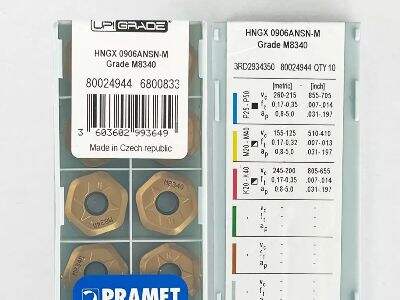As ons dit oorweeg om dit oor 'n ander materiaal te vorm, gebruik ons gewoonlik CNC-snygereedskap. Hierdie gereedskap is ontwerp om akkurate snywerk te maak, wat baie belangrik is wanneer jy probeer om vorms en ontwerpe te bewerkstellig. Oor die algemeen moet u die doeltreffendste gereedskap vir u werk kies, aangesien verskillende materiale verskillende soorte CNC-snytoestelle benodig. Die keuse van die regte instrument kan 'n speletjie-wisselaar wees in die uitkoms van jou projek. Kom ons vind uit hoe verskillende materiale die gereedskap wat jy kies kan verander en die impak wat dit op jou werk het.
Die effek van materiaal hardheid op gereedskap seleksie
’n Maklike manier om dit te oorweeg, is om te kyk na die hardheid van watter materiaal jy ook al sny. Die hardheidvlak een sal baie in ag geneem word wanneer dit gaan oor die keuse van 'n gereedskap. Metaal en taai plastiek (regtig harde dinge) benodig iets wat ongelooflik veerkragtig en duursaam is. kan gemaak word uit materiaal soos wolframkarbied of diamant wat draadfreesgereedskap staan goed teen die druk, spanning en slytasie van sny van harde substraat, maar sal nie afbreek of andersins foutief en onbruikbaar word wanneer met die meer kragtige materiale gewerk word nie.
Sagter materiale, soos skuim, hout en sekere plastiek, vereis minder kragtige gereedskap. Vir meer meebringbare materiale van hierdie tipe, sal enige gereedskap gemaak van hoëspoedstaal werk. Hierdie gereedskap is uiters skerp en werk soos 'n mes deur botter, maar sonder om enige sagte materiaal seer te maak. Om die verskil in hardheid te ken, kan jou help om te besluit watter gereedskap jy vir jou projek benodig.
Waarom materiaal duursaamheid belangrik is
Dan moet ons dink oor hoe taai die goed is. Hierdie titanium boorpunte vir metaal is ook uiters belangrik vir die keuse van 'n CNC-snygereedskap. Aluminium is byvoorbeeld 'n baie duursame en sterk materiaal. Jy benodig dus 'n snygereedskap wat nie net sy taaiheid kan weerstaan nie, maar ook dwarsdeur dit sal sny. Wanneer deur taai materiale (soos aluminium) gesny word, sal 'n mens 'n gereedskap met 'n hoë snykantsterkte benodig om 'n skoon snit te maak.
Maar sommige meer smeebare metale, soos koper of koper, is nie heeltemal so duursaam nie. Jy kan 'n minder robuuste gereedskap gebruik wat 'n verminderde snydruk het. Dit beteken dat jy 'n ligter, meer hanteerbare hulpmiddel kry. Dus, wanneer jy jou gereedskap kies om te sny vir die werk op hande, moet jy oorweeg hoe taai of duursaam 'n materiaal is.
Materiaaldikte maak die verskil
Die ander belangrike oorweging is die dikte van die materiaal wat jy sny. Dikte sal 'n aansienlike impak hê op watter tipe gereedskap jy benodig. Hierdie teël sny boorpunt beteken dat jy 'n klein snykant nodig het vir dun materiale. aangesien te veel krag kan buig, kromtrek of die vorm van dun materiale kan verander, wil jy dit nie in jou projek hê nie.
Wanneer jy met dikker materiale werk, benodig jy 'n werktuig wat doeltreffend is en langer hou. Hierdie gereedskap is gemaak om mafuta wat dikker is sonder om te breek stil te maak. Die keuse van die regte gereedskap relatief tot die dikte van die materiaal sal jou help om jou sny akkuraat en skoon te hou.
Hoe verander materiaal watter gereedskap jy gebruik
Materiaaltipe is die sleutel tot die keuse van CNC-snygereedskap. Alhoewel jy dieselfde metodes kan gebruik om baie verskillende materiale te sny, kan die materiaal self beïnvloed hoe jy dit moet sny. Byvoorbeeld, wanneer jy hoëtemperatuurmateriale soos titanium sny, moet jy dit gewoonlik afwater. Die koelmiddel verhoed dat die snygereedskap te warm word, wat beide die gereedskap en die materiaal kan verwoes.
Sommige sagte plastiek smelt selfs wanneer dit gesny word. Om hierdie probleem te voorkom, sal rubberagtige materiaal soos Delrin wat nie smelt nie, beter snyresultate hê. Die identifisering van die loodmateriaal stel jou in staat om die regte gereedskap en snymetode te kies.
Deel een: Gereedskap- en materiaalversoenbaarheid - hoekom dit saak maak
Ten slotte moet ons oorweeg hoe goed die materiaal en die gereedskap by mekaar pas. Dit is van kardinale belang om die twee aan te vul vir effektiewe sny. Enigiets van die tipe materiaal tot die vorm van die gereedskap, die snyhoek van die gereedskap kan beïnvloed hoe goed hulle saamwerk. Dit is belangrik dat die gereedskap en die materiaal versoenbaar is, om die beste resultate in jou snyprojekte te behaal.
Huazhichun en ander maatskappye vervaardig verskillende soorte gereedskap vir sekere materiale en toestande. Hul indekseerbare karbiedsnygereedskap is byvoorbeeld ontwerp om 'n wye reeks ysterhoudende (yster-gebaseerde) en nie-ysterhoudende (nie-yster-gebaseerde) materiale doeltreffend te verwerk. Dit beteken, afhangende van waarmee jy weet hoe om te werk, jy het baie opsies om van te kies.
Om op te som, die keuse van CNC-snygereedskap wat gebruik moet word, word bepaal deur verskeie faktore, insluitend materiaaltipe, hardheid, dikte, sterkte en verenigbaarheid met die gereedskap. Al hierdie faktore help jou om werkverwante funksie met betrekking tot die spesiale behoeftes te verrig. Jy sal akkuraat en doeltreffend sny, vir 'n beter uitkoms in jou projekte, want Huazhichun maak CNC-snygereedskap vir die werk.
 EN
EN
 AR
AR
 BG
BG
 HR
HR
 CS
CS
 DA
DA
 NL
NL
 FI
FI
 FR
FR
 DE
DE
 EL
EL
 IT
IT
 JA
JA
 KO
KO
 GEEN
GEEN
 PL
PL
 PT
PT
 RU
RU
 ES
ES
 SV
SV
 IW
IW
 ID
ID
 LV
LV
 LT
LT
 SR
SR
 SK
SK
 SL
SL
 UK
UK
 SQ
SQ
 ET
ET
 HU
HU
 TH
TH
 TR
TR
 FA
FA
 AF
AF
 MS
MS
 MK
MK
 KA
KA
 UR
UR
 BN
BN


